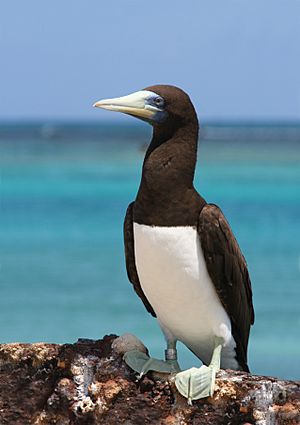Bedout Island facts for kids
Bedout Island is a tiny Australian island located in the eastern part of the Indian Ocean. It is about 42 kilometers (26 miles) away from Larrey Point and the mouth of the De Grey River. The island is also about 96 kilometers (60 miles) northeast of Port Hedland, which is on the Pilbara coast in northwest Western Australia.
About Bedout Island
Bedout Island is a low, sandy island that covers about 31 hectares (77 acres). It sits on a base of limestone rock. The island is covered with a special type of grass called beach spinifex.
The island has a very dry climate, meaning it doesn't get much rain. On average, it receives only about 300 millimeters (12 inches) of rain each year. Sometimes, big storms called tropical cyclones hit the island.
In the middle of Bedout Island, there is a special light called a navigational beacon. This light helps ships find their way. There are also three old shipwrecks in the waters around the island. These ships sank between the years 1890 and 1912.
A long time ago, some black rats accidentally came to the island. They probably arrived on pearling ships in the late 1800s. But in 1991, all the rats were removed from the island. This was done to protect the native animals and plants.
Island's Special Status
Bedout Island is a very important place, so it is protected as an A-class nature reserve. This means it's a special area where nature is kept safe. The island is looked after by the Department of Environment and Conservation.
Bedout Island is also part of a larger area called the Western Australian Coastal Islands. This whole area is listed on Australia's Register of the National Estate. This list includes places that are important to Australia's history and nature.
Because so many birds live and breed here, BirdLife International has named Bedout Island an Important Bird Area. This means it's one of the most important places in the world for birds.
Amazing Birds of Bedout Island
Bedout Island is a super important home for many different kinds of seabirds.
Over 1,000 pairs of brown boobies build their nests on the island. This makes it one of the biggest brown booby nesting sites in all of Western Australia. Sometimes, these birds accidentally use trash like plastic pieces, rope, or fishing line in their nests. They probably mistake these items for natural nesting materials. In 2016 and 2017, about 5% of the nests had this kind of debris.
The island is also home to more than 1,000 pairs of common noddies and crested terns that build their nests here. You can also find 500 to 1,000 lesser frigatebirds and 100 to 500 masked boobies.
Other birds that live on Bedout Island include lesser crested terns, roseate terns, sooty terns, silver gulls, and white-bellied sea eagles. Many of these birds do not breed anywhere else in the Pilbara region. The main time for birds to lay their eggs and raise their young is during the winter months, from May to September.



